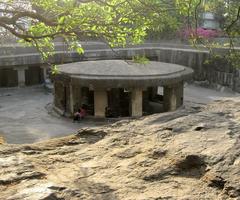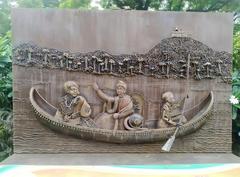Someshwar Mandir Pune: Visiting Hours, Tickets, and Historical Significance
Date: 03/07/2025
Introduction
Someshwar Mandir, a prominent and ancient temple dedicated to Lord Shiva, is nestled in the vibrant city of Pune. Revered as a spiritual nucleus and a marvel of Hemadpanti architecture, the temple stands on the tranquil banks of the Ramnadi (a tributary of the Mula River), in the Someshwarwadi area of Pashan. With roots extending back to the Yadava period and significant enhancements during the Maratha and Peshwa eras, Someshwar Mandir is celebrated for its historical depth, intricate stonework, and enduring role as a cultural and community hub (Pune Tourism).
This comprehensive guide covers essential information for visitors, from historical and cultural significance to practical details such as visiting hours, entry policies, accessibility, rituals, festivals, and travel tips. Whether you are a devotee, a history enthusiast, or a traveler interested in Pune’s heritage sites, Someshwar Mandir offers a unique and immersive experience.
Table of Contents
- Introduction
- History and Architectural Heritage
- Religious and Cultural Significance
- Visiting Hours and Entry Information
- Accessibility and Facilities
- Major Festivals and Rituals
- Dress Code and Visitor Etiquette
- Travel Tips and Nearby Attractions
- Frequently Asked Questions (FAQs)
- Summary and Visitor Recommendations
- References & Further Reading
History and Architectural Heritage
Early Origins
Someshwar Mandir’s origins trace back to the Yadava dynasty (12th–14th centuries CE), as evidenced by its Hemadpanti architectural style—characterized by the use of locally sourced black basalt stone without mortar (StylesAtLife). The temple is said to have been constructed in the 17th century by Jijabai, mother of Chhatrapati Shivaji Maharaj, and later renovated by Hanumante, one of Shivaji’s ashta pradhans. The temple’s enduring structure and sacred Shiva Lingam (believed to be swayambhu, or self-manifested) underscore its ancient legacy (Academia.edu).
Architectural Features
- Sanctum (Garbhagriha): Houses the swayambhu Shiva Lingam, adorned with a distinctive golden mask.
- Sabha Mandap (Assembly Hall): Features intricately carved ceilings, with some elements attributed to Mughal general Shahiste Khan, reflecting Indo-Islamic influences.
- Deepmala (Lamp Tower): A 40-foot-high stone lamp tower, illuminated during festivals.
- Nandi Mandap: Prominently displays the sacred bull Nandi, carved from a single basalt block.
- Subsidiary Shrines: Dedicated to Bhairavnath, Hanuman, and Ganesh.
- Courtyard and Entrances: The complex features three main entrances and a traditional ghat leading to the river.
The temple’s stonework includes floral, geometric, and mythological motifs, as well as rare images of Nath-siddhas, reflecting the region’s spiritual diversity and craftsmanship (Academia.edu).
Religious and Cultural Significance
Someshwar Mandir is more than a place of worship; it is a spiritual, social, and cultural anchor for Pune’s residents. The temple’s Shivalinga symbolizes Lord Shiva as “Someshwar”—the Lord of the Moon—invoked for blessings of mental peace, health, and prosperity. Its sacred rituals, community gatherings, and festivals foster social cohesion and perpetuate centuries-old traditions (Trip.com).
The temple has witnessed dynastic changes, from the Yadavas to the Marathas and Peshwas, and has played a pivotal role in shaping Pune’s religious identity. Community events, spiritual discourses, and charitable activities continue to reinforce its importance in the city’s cultural fabric (AroundInPune).
Visiting Hours and Entry Information
- Timings: The temple is open daily, with most sources indicating visiting hours from 6:00 AM to 8:00 PM (StylesAtLife), and some sources noting slightly different timings such as 8:00 AM to 7:00 PM (TravelTriangle). For morning and evening rituals, it is best to visit early or late in the day.
- Entry Fee: Entry is free for all visitors. Donations are welcome and help maintain the temple and its charitable activities.
- Guided Tours: While official tours are not regular, local guides and temple staff are available to share insights into the temple’s history and rituals (TempleYatri).
Accessibility and Facilities
- Location: Someshwarwadi, Pashan, Pune. Approximately 8–10 km from Pune Junction Railway Station and 17 km from Pune International Airport. Easily reachable by road, with parking available nearby (TravelTriangle).
- Facilities: Clean restrooms, drinking water, shaded seating, and a landscaped garden with play areas for children.
- Accessibility: Pathways are generally level and well-maintained, though some areas (such as stone steps to the river ghat) may require assistance for elderly or mobility-impaired visitors. Ramps are available at main entrances.
- Safety: The temple is considered safe, with additional security during major festivals.
Major Festivals and Rituals
- Maha Shivaratri: The temple’s most prominent festival, marked by elaborate decorations, night-long prayers, music, and the Palkhi procession featuring the panchdhatu idol of Lord Shiva (AroundInPune).
- Shravan Maas (July–August): A month of special rituals and increased devotee activity, with offerings of milk, water, and bilva leaves to the Shivalinga.
- Other Rituals: Daily abhishek (ritual bathing), aarti (lamp worship), and community events. Mondays are considered especially auspicious for Shiva worship.
The temple also hosts religious discourses, annadanam (community meals), and cultural programs throughout the year (TempleYatri).
Dress Code and Visitor Etiquette
- Dress Code: Traditional attire is recommended—kurta-pajama or dhoti-kurta for men, sarees for women, especially while participating in rituals (PuneTourism).
- Footwear: Remove shoes before entering the temple premises.
- Photography: May be restricted in certain areas, particularly near the sanctum. Always seek permission before taking photos (TempleYatri).
- Conduct: Maintain silence during rituals, respect ongoing ceremonies, and use designated areas for eating or resting.
Travel Tips and Nearby Attractions
- Best Time to Visit: Early mornings and late afternoons offer a tranquil atmosphere. Festival seasons, especially Maha Shivaratri and Shravan, provide vibrant cultural experiences but can be crowded.
- Getting There: Private vehicles, taxis, and local buses provide convenient access from Pune city center and major transit points.
- Nearby Attractions:
- Shaniwar Wada: Iconic Maratha fort.
- Dagdusheth Halwai Ganapati Temple: Renowned Ganesh temple.
- Raja Dinkar Kelkar Museum: Collection of artifacts and regional art.
- Balewadi Stadium and Gram Sanskruti Udyan Village Park: Leisure spots nearby (ZeeZest).
For a comprehensive Pune itinerary, consider combining your temple visit with these historic and cultural sites.
Frequently Asked Questions (FAQs)
Q: What are Someshwar Mandir’s visiting hours?
A: Most sources indicate 6:00 AM to 8:00 PM daily, but timings may vary slightly.
Q: Is there an entry fee?
A: No, entry is free for all visitors.
Q: Are guided tours available?
A: Official guided tours are not regular, but local guides and temple staff can provide historical and ritual insights.
Q: Is the temple accessible for differently-abled visitors?
A: The temple is generally accessible, though some areas may require assistance.
Q: What festivals are celebrated at the temple?
A: Maha Shivaratri and Shravan Maas are major festivals, along with daily and weekly rituals.
Q: What is the dress code?
A: Traditional attire is recommended; footwear must be removed before entry.
Summary and Visitor Recommendations
Someshwar Mandir exemplifies Pune’s harmonious blend of spirituality, architecture, and community heritage. Its centuries-old Hemadpanti design, revered swayambhu Shivalinga, and vibrant festivals make it a focal point of cultural and religious life in the city. The temple’s free entry, thoughtful facilities, and proximity to other historic sites make it accessible and appealing to all visitors (PuneTourism; Trip.com).
Visitors are encouraged to plan their trip during the quieter hours for a serene experience or to participate in festivals for a glimpse into Pune’s living traditions. Respect for dress codes and temple etiquette will ensure a fulfilling and respectful visit. To further enrich your journey, explore related Pune landmarks and consider using resources such as the Audiala app for updated guides and personalized travel tips.
References & Further Reading
- Someshwar Mandir Visiting Hours, Tickets, and Historical Guide to Pune’s Ancient Shiva Temple (2025) (Pune Tourism)
- Someshwar Mandir Pune: Visiting Hours, Festivals, and Cultural Significance (2025) (Trip.com)
- Someshwar Mandir Pune: Visiting Hours, Tickets, Architectural Highlights, and Visitor Guide (2025) (StylesAtLife)
- Someshwar Mandir Visiting Hours, Tickets, and Guide to Pune Historical Sites: A Complete Visitor Experience (2025) (TravelTriangle)
- ART AND ARCHITECTURE OF SOMESHWAR TEMPLE AT PIMPRI DUMALA PUNE DISTRICT MAHARASHTRA (Academia.edu)
- Someshwar Wadi at Pashan (AroundInPune)
- More about Pune’s temples and related attractions (ZeeZest)
Plan your visit to Someshwar Mandir today and experience Pune’s living heritage. For guided tours and exclusive heritage content, download the Audiala app and follow our updates on social media.




